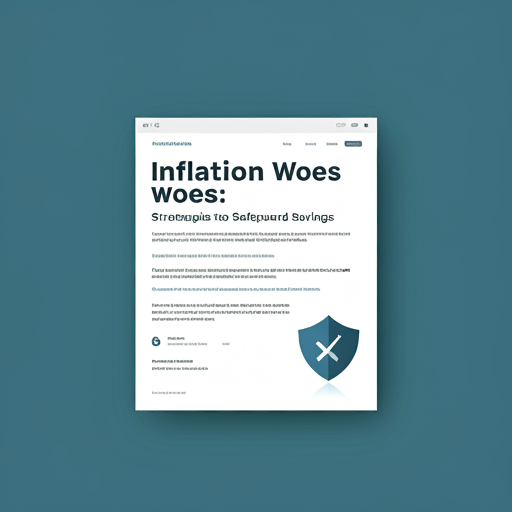Introduction to Inflation and Its Impact on Savings
Understanding Inflation: Causes and Effects
Inflation represents the rate at which the general level of prices for goods and services rises, eroding purchasing power. This phenomenon can significantly impact savings, as the real value of money diminishes over time. Consequently, individuals may find that their accumulated wealth buys less than it did previously. It’s a concerning reality for many savers.
Moreover, inflation can lead to increased interest rates as central banks attempt to control rising prices. Higher interest rates can discourage borrowing and spending, further affecting economic growth. This creates a complex interplay between inflation and economic activity. Understanding this relationship is crucial for effective financial planning.
In his view, individuals must consider inflation when strategizing their savings. Ignoring inflation can lead to substantial financial losses. Therefore, it is essential to adopt proactive measures to safeguard savings against its effects.
The Current State of Inflation and Its Implications
The current state of inflation is characterized by risigg prices across various sectors, significantly affecting consumer behavior and economic stability. This trend can lead to increased costs for essential goods and services, impacting individuals’ disposable income. Many people are feeling the pinch.
As inflation persists, it can create uncertainty in financial markets, prompting individuals to reassess their investment strategies. He may find that traditional savings accounts yield insufficient returns to keep pace with inflation. This situation necessitates a more strategic approach to wealth preservation.
In his opinion, diversifying investments into assets that historically outperform inflation is crucial. Real estate and commodities often serve as effective hedges. Understanding these dynamics is vital for making informed financial decisions.
The Role of Cryptocurrency in Inflation Hedge
How Cryptocurrencies Function as a Store of Value
Cryptocurrencies have emerged as a potential store of value, particularly in times of economic uncertainty. Their decentralized nature allows individuals to hold assets outside traditional financial systems. This can be particularly advantageous during inflationary periods. Many investors are exploring this option.
Key characteristics that contribute to cryptocurrencies functioning as a store of value include:
In his view, these attributes make cryptocurrencies appealing as a hedge against inflation. They offer an alternative to fiat currencies, which can lose value due to inflationary pressures. Understanding these factors is essential for informed investment decisions.
Comparing Cryptocurrencies to Traditional Assets
Cryptocurrencies and traditional assets serve different purposes in an investment portfolio. While traditional assets like stocks and bonds are often tied to economic performance, cryptocurrencies operate independently of these factors. This independence can provide a unique hedge against inflation. Many investors are intrigued by this.
Key differences include:
In his opinion, understanding these distinctions is vital for effective asset allocation. Investors should consider their risk tolerance and investment horizon.
Strategies for Protecting Your Savings Against Inflation
Diversifying Your Investment Portfolio
Diversifying an investment portfolio is essential for mitigating risks associated with inflation. By allocating assets across various classes, he can reduce exposure to any single economic event. This strategy enhances overall portfolio stability. It’s a prudent approach.
Effective diversification may include:
In his view, a well-rounded portfolio should also incorporate alternative investments, such as cryptocurrencies. These assets can provide additional protection against inflationary pressures. Understanding these strategies is crucial for long-term financial health.
Utilizing Stablecoins for Stability
Utilizing stablecoins can provide a reliable means of maintaining value in an inflationary environment. These digital currencies are pegged to stable assets, such as fiat currencies, which helps mitigate volatility. This stability is crucial for preserving purchasing power. Many investors appreciate this feature.
Stablecoins can serve various functions in a portfolio:
In his opinion, incorporating stablecoins into an investment strategy is a prudent choice. Understanding their role can enhance financial resilience.
Long-Term vs. Short-Term Strategies
Assessing Your Financial Goals and Risk Tolerance
Assessing financial goals and risk tolerance is essential for effective investment planning. He must consider both long-term and short-term strategies to align with his objectives. Long-term strategies typically focus on growth and capital appreciation. They require patience and a higher risk tolerance.
In contrast, short-term strategies prioritize liquidity and capital preservation. These approaches often involve lower risk but may yield reduced returns. Understanding the time horizon is crucial.
He should evaluate his financial situation and market conditions regularly. This assessment helps in making informed decisions. A well-defined strategy can enhance financial outcomes.
When to Shift Strategies Based on Market Conditions
Shifting strategies based on market conditions is crucial for optimizing investment performance. He must remain vigilant to economic indicators and market trenrs. For instance, during periods of economic expansion, long-term strategies may yield higher returns. Growth opportunities abound.
Conversely, in a downturn, short-term strategies can help preserve capital. This approach minimizes exposure to volatile assets. Understanding market cycles is essential.
He should regularly review his portfolio to ensure alignment with current conditions. Adapting strategies can enhance resilience. Staying informed is key to successful investing.
Conclusion: Taking Action to Safeguard Your Financial Future
Recap of Key Strategies Discussed
Key strategies discussed include diversifying investments and utilizing stablecoins. These approaches can help mitigate risks associated with inflation. He should consider asset allocation carefully.
Additionally, assessing financial goals and risk tolerance is essential. This evaluation guides investment decisions. Regularly reviewing market conditions allows for timely strategy adjustments. Staying proactive is vital.
In his opinion, taking action is crucial for safeguarding financial futures. Implementing these strategies can enhance resilience against economic fluctuations. Knowledge is power in financial planning.
Encouragement to Stay Informed and Adapt
Staying informed about market trends and economic indicators is essential for effective financial management. He must regularly review credible sources of information. This practice enables timely adjustments to investment strategies. Knowledge is crucial.
Key areas to monitor include:
In his opinion, adaptability is key to long-term success. He should embrace continuous learning and remain flexible. Proactive engagement can significantly enhance financial outcomes.
